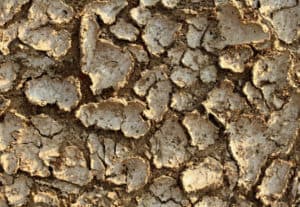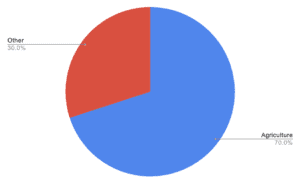
Agricultural open field farming has been a staple in human communities since they were first developed. However, there are a lot of problems that this type of farming produces. These problems can be overcome by adopting a new farming method called vertical farming.
What are the biggest problems that vertical farming has the potential to solve and how they can be solved? I look into them more closely in this article.
1. Water Shortage
Despite the fact that our planet is covered mainly with water, over 785 million people are suffering from a lack of access to fresh water worldwide. Agriculture accounts for 70% of global yearly water use, which is the largest contributor to water scarcity. Agricultural farmers use more water than any other group combined, and this heavy usage of water contributes to a lot of environmental and social problems.

Compared to regular farming, vertical farming consumes less than 5% of the amount of water that regular open-field agriculture uses. It uses hydroponics, aquaponics, and aeroponics methods in which water circulates in a closed-loop so nothing is wasted. Because the environment is fully controlled indoors, it is also possible to recover water that evaporates from plants’ leaves by using dehumidifiers.
2. Deforestation
All arable land on earth has been already used for agriculture, and expanding farming operations is not possible without cutting down the forests to create more space for plants to grow horizontally. That causes huge deforestation problem which in turn contributes to worse quality of the air we breathe in. Over 24 million hectares of forest are cut down each year, an area comparable to that of Great Britain.

Vertical farming, as the name suggests, grows plants in vertical layers thus saving a huge amount of space. Some of the farms are able to grow even 300 times more food from 1 square meter compared to open field farming. Fewer requirements for space could stop deforestation practices. Furthermore, the recovered space could be used to restore forests lost in the past.

Shop The Farmstand – Self-Watering, Self-Fertilizing Solution for an Easy to Grow Harvest
3. Biodiversity Loss
Limiting forest areas also destroys biodiversity. Scientists say that we are undergoing a sixth mass extinction of species in the history of the Earth. According to the WWF foundation, the population of terrestrial species declined by over 38% since 1970. The main cause is the destruction of their natural habitats due to the conversion of land for agricultural purposes. It is even worse with freshwater animals: since 1970, their populations have declined over 81% as a result of drainage of wetlands, also for agriculture.
With the use of vertical farming, these natural habitats could be spared. The land saved from open-field agriculture could be used to restore and build up new natural habitats for wildlife.
4. Soil Erosion and Desertification
Soil Erosion is a huge problem caused mainly by farming and open field agriculture. Some soils cannot withstand the transition from natural vegetation to crops, which leads to soil erosion on the topsoil layer. Desertification is when soil becomes dried up and unable to inhabit or support crops. This kind of soil is commonly seen in drylands.
These phenomena are mainly caused by the excessive grazing of cattle and the leaching of soil by intensive drainage. With the growth of urban development by 2050, desertification is expected to take almost 18% of the land area currently suitable for agricultural use. Already every year (sic!) we lose as much as 12 million hectares of land as a result of desertification, which is almost as much as the area the size of Greece.
Because vertical farming uses soil-less growing methods mentioned above, it doesn’t contribute to soil erosion at all.
5. Access to Fresh, Healthy Food
The population in 2050 is estimated to grow to up to 60% larger than it was in the year 2000. With the increase in population, food production will also have to increase. For agricultural farming to sustain the population, it will have to increase its production rate by 70% while rapidly losing land and resources. Even with improvements in yields every year, that seems to be impossible.
Vertical farming, on the other hand, has much higher productivity than traditional agriculture. It also democratizes access to fresh food for people who live in food deserts or tough climate regions.
6. Dwindling Number of Farmers
In the past, farming was considered a valuable and very common career. Many farming families would have their children start working on the farm early and then would go on to inherit the farm later in life. However, times are changing and fewer young people are interested in a farming career, thus the average age of farmers is continually increasing.
With the rate that farming is going and the number of farmers needed to tend crops, there will not be enough farmers to continually sustain open-field agriculture in the nearby future.
Vertical farming, on the other hand, seems to be more interesting for young people because it allows them to work with modern technologies. Since it can be done anywhere (even in city centers) people don’t have to stay in rural areas to become farmers.
7. Food Transparency
Food that is bought currently is often produced thousands of miles away and then shipped to grocery stores and restaurants. Having the food grown so far away makes it difficult to know how it is produced and processed. The long food chain system is also very prone to contamination with food-borne illnesses.
On the other hand, vertical farming is super local, so people can have full food transparency to know how, where, and when their food is grown. It is usually possible to come and see the vertical farm and have the opportunity to personally meet the people who grow the food.
8. Food on Mars and Moon Colonies
With the way that space travel is heading, and with the Mars One mission, astronauts are looking for a sustainable way to grow and produce food that will efficiently support life on Mars.
Unlike traditional open-field agriculture, vertical farming can grow and sustain plants in outer space. The plants are grown in an indoor, controlled environment that can be replicated anywhere. These vertical farming units are ideal for colonization, whether that be on mars or moon colonies.
9. Price Stability and Regular Access to Fruits and Vegetables
The environment is consistently changing, and crops are subject to abnormal weather patterns, which means they can be easily destroyed. When crops are destroyed, the price of the remaining plants goes up. This can cause a problem for restaurants and other companies that rely on the stability of prices for financial planning.
Vertical farming is not subject to abnormal weather patterns or changing environmental conditions. The environment is controlled and therefore can produce very consistent results. With consistency in results, prices will stay the same, and these steady prices will be better for businesses to plan and prepare for their estimated costs.
So now that we have talked about what problems vertical farming can solve, let’s talk about how you can solve your own problems with not having a system for yourself at home that you can grow green goodness in. If you want to get your own crops growing at home, I recommend this complete kit, and these seeds to go with it. All under $200, for crops that re-grow. Seriously, check out the reviews and decide for yourself!
